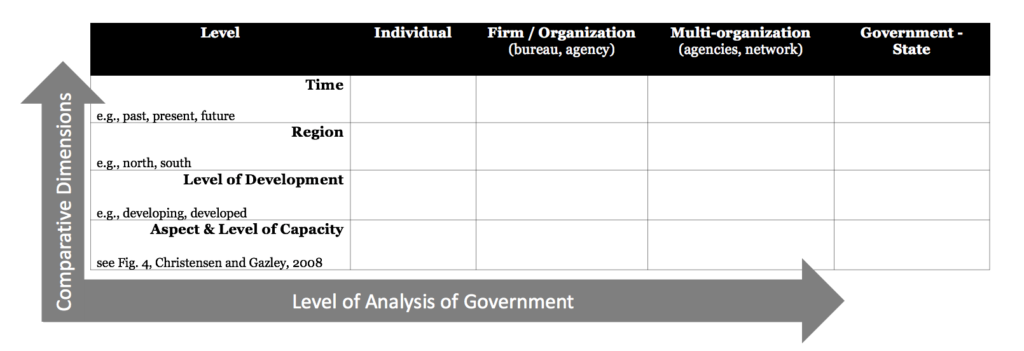Symposium: Advancing Government Quality through Capacity and Competitiveness
Symposium Editors
Tobin Im Seoul National University | Center for Government Competiveness (tobin@snu.ac.kr)
Robert K. Christensen Brigham Young University (rc@byu.edu)
Lotte Bøgh Andersen, Aarhus University (lotte@ps.au.dk)
Background: The research on government performance has enjoyed decades of development, resulting in an arguably robust–albeit evolving–interface with practice/application (e.g., Wechsler and Clary, 2000; Kroll and Moynihan, 2018). Performance researchers also actively revisit and refine performance’s conceptual space (Andersen, Boesen, Pedersen, 2016).
The complementary concepts of government capacity and competitiveness, on the other hand, remain less well developed. Regarding capacity, which some argue to be a necessary precursor to performance, Christensen and Gazley (2008, p. 266) noted a persistent, “fragmented and disarrayed approach to the use of ‘capacity’ in conceptual and empirical work.” Regarding competitiveness, Im and Choi (2016) argued that even commonly used indices “lack clear definitions of competitiveness and suffer from weak theoretical support” (Im and Hartley, 2017, p. 1). The result seems to be a picture of public organizations where only part of the landscape—performance—is focused but one where there is nevertheless “very little agreement on what constitutes high-quality government” (Fukuyama, 2013, p. 1).
In an effort to offer some conceptual coalescence to remedy the disagreement, we offer (1) the following logic model—see Figure 1—to indicate, at the highest level, a plausible sequence of relationships and (2) a few definitions as points of reference. These are intended to stimulate, rather than confine, potential contributions.

Figure 1 Constituent Elements and Relationships of Government Quality
- Organizational capacity has been defined as “government’s ability to marshal, develop, direct and control its financial, human, physical and information resources” (Ingraham et al., 2003, p. 15).
- Government competitiveness has been defined as “the power of government, in light of various constraints, to take resources from in and outside of the country and improve social, economic and cultural conditions of the nation in order to sustainably enhance citizens’ quality of life” (Im and Choi, 2018, p. 516).
Even after the cold war era when US government rivaled strongly USSR government, governments across the globe compete in many ways. Government operations have evolved enormously over recent years–from direct intervention to alternative forms of governance, innovation, network management and participation. Consequently, the role and scope of a particular government varies by region and time: from fragile state to developmental state (Roberts, 2018). Given these complexities, understanding government quality, capacity and competitiveness, in particular, may require a multi-dimensional approach (see Figure 2, again meant to illustrate possible approaches without discouraging others).

Figure 2 Multidimensional Approach to Government Quality
Objective. The purpose of this symposium is to invite theoretical and empirical work that better aligns, clarifies, and integrates the concepts of government capacity and competitiveness relative to each other, and with the more developed concept of performance. The goal is a more fulsome assessment of government quality. Of course, many complementary concepts also occupy this space including innovation, strategy, networks, finance, and learning/openness. Methodologies will vary widely but we strongly encourage some submissions taking up comparative/cross country approaches.
Timeline
- Sep 15, 2018– Paper proposal (maximum 1,000 words) should be submitted via e-mail, copying each of the symposium co-editors.
- Oct 15, 2018– Decision on paper proposal communicated to authors.
- Jan 15, 2019– One-day conference at a location TBD (sponsored by the Seoul National University, Government Competitiveness Center; Aarhus University, Crown Prince Frederik Center for Public Leadership; Brigham Young Unviersity, Romney Institute of Public Service and Ethics). Authors of accepted proposals are strongly encouraged to participate.
- Feb 15, 2019– Complete manuscripts to be submitted via e-mail, copying each of the symposium co-editors, for final screening and feedback.
- Mar 15, 2019– Manuscripts to be submitted to PAR’s online editorial system (par.edmgr.com). Manuscripts will undergo the journal’s normal peer review process as overseen by PAR Co-Editors-in-Chief, Jeremy Hall and Paul Battaglio.
References
Andersen, L. B., Boesen, A., & Pedersen, L. H. (2016). Performance in public organizations: Clarifying the conceptual space. Public Administration Review, 76(6), 852-862.
Christensen, R. K., & Gazley, B. (2008). Capacity for public administration: Analysis of meaning and measurement. Public Administration and Development, 28(4), 265-279.
Fukuyama, F. (2013). What is governance? Governance, 26(3), 347–368.
Im, T., & Choi, Y. (2016). Rethinking national competitiveness: A critical assessment of governmental capacity measures. Social Indicators Research. https:doi.org/10.1007/s11205-016-1494-z.
Im, T., & Hartley, K. (2017). Aligning Needs and Capacities to Boost Government Competitiveness. Public Organization Review, 1-19.
Ingraham PW, Joyce PG, Donahue AK. 2003. Government Performance: Why Management Matters. Johns Hopkins University Press: Baltimore.
Kroll, A., & Moynihan, D. P. (2018). The Design and Practice of Integrating Evidence: Connecting Performance Management with Program Evaluation. Public Administration Review, 78(2), 183-194.
Roberts, Alasdair(2018), Strategies for Governing: an approach to public management for west and east, Korean Journal of Policy Studies, 33(1):25-56
Wechsler, B., & Clary, B. (2000). Implementing performance government: A symposium introduction. Public Productivity & Management Review, 264-266.